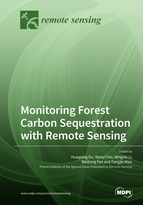Monitoring Forest Carbon Sequestration with Remote Sensing
A special issue of Remote Sensing (ISSN 2072-4292). This special issue belongs to the section "Forest Remote Sensing".
Deadline for manuscript submissions: closed (15 December 2022) | Viewed by 72679
Special Issue Editors
Interests: the remote sensing monitoring of bamboo forest resources; the remote sensing quantitative estimation of carbon cycle
Special Issues, Collections and Topics in MDPI journals
Interests: quantitative remote sensing techniques; carbon cycling models used in forest ecosystems
Interests: forest disturbance and recovery mapping from long-term landsat observations; mapping forest structural parameters from multi-source remote sensing and machine learning; characterizing urban impervious surface from deep learning; forest dynamics and its climate change effects; landscape ecology and forest fragmentation
Special Issues, Collections and Topics in MDPI journals
Interests: quantitative remote sensing; canopy radiative transfer modeling
Special Issues, Collections and Topics in MDPI journals
Special Issue Information
Dear Colleagues,
The forest, as the main body of the terrestrial ecosystem, has a huge carbon sink function and plays an important role in coping with global climate change. This Special Issue on “Monitoring forest carbon sequestration with remote sensing” mainly foucuses on new remote sensing theories, methods, and technologies for monitoring carbon sinks in forest ecosystems (including urban forest ecosystems) and calls for papers that present original research on the following broad topics:
- Application of new remote sensing techniques to estimate forest aboveground biomass carbon storage and soil carbon storage.
- Coupling remote sensing and ecosystem models to simulate the carbon cycle of a forest ecosystem.
- Application of new sensors or algorithms to retrieve vegetation parameters closely related to forest carbon sink functions, such as leaf area index, tree height, chlorophyll, maximum rate of rubisco carboxylase activity, sun-induced chlorophyll fluorescence, forest age, etc.
- Integration of multi-temporal or multi-sensor data to detect dynamic changes in and distrubances of forest resources.
Dr. Huaqiang Du
Prof. Dr. Wenyi Fan
Prof. Dr. Mingshi Li
Dr. Weiliang Fan
Dr. Fangjie Mao
Guest Editors
Manuscript Submission Information
Manuscripts should be submitted online at www.mdpi.com by registering and logging in to this website. Once you are registered, click here to go to the submission form. Manuscripts can be submitted until the deadline. All submissions that pass pre-check are peer-reviewed. Accepted papers will be published continuously in the journal (as soon as accepted) and will be listed together on the special issue website. Research articles, review articles as well as short communications are invited. For planned papers, a title and short abstract (about 100 words) can be sent to the Editorial Office for announcement on this website.
Submitted manuscripts should not have been published previously, nor be under consideration for publication elsewhere (except conference proceedings papers). All manuscripts are thoroughly refereed through a single-blind peer-review process. A guide for authors and other relevant information for submission of manuscripts is available on the Instructions for Authors page. Remote Sensing is an international peer-reviewed open access semimonthly journal published by MDPI.
Please visit the Instructions for Authors page before submitting a manuscript. The Article Processing Charge (APC) for publication in this open access journal is 2700 CHF (Swiss Francs). Submitted papers should be well formatted and use good English. Authors may use MDPI's English editing service prior to publication or during author revisions.
Keywords
- Forest biomass
- Forest carbon storage
- Forest carbon cycle
- Remote sensing model
- Forest parameter








